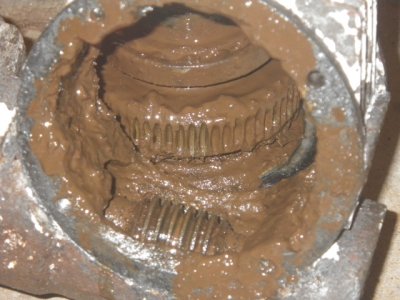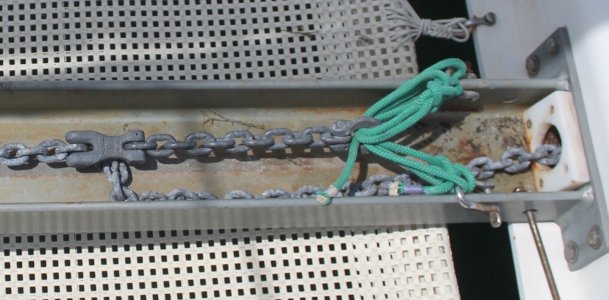Roberto
Well-Known Member
ooops, posted on an anchor thread 
Last edited:
I had an early season incident before I had sorted my chain marking.
We dragged quite badly in a 35 knot squall. It was a very black night only lit by the lightening storm.
I had to reset our anchor 8 times before it finally found some good holding.
I managed to mark our anchor chain about a meter before the rope splice and just before the anchor hits the bow roller with some reflective tape after the second anchor drag.
I could not see the existing colored ribbons from the cockpit.
Using a torch other than a red head light is ill advised as this destroys your night vision. Anchoring in a safe manner in close proximity to other boats is hard enough on a pitch black night.
Thoroughly recommend reflective tape at each end of your anchor chain rode.
I have a horizontal windlass which has no problem with catching or ripping tapes off.
I thought this was a post about anchor rode marking!
My contribution was to say I found reflective tape at the end of my rode allowed me to hoist and redeploy my anchor 5 times in challenging conditions from the safety of my centre cockpit without putting myself or my partner at risk in the dark on a moving foredeck. I have a remote and can operate my windlass from anywhere on the boat.
I found the reflective tape was picked up by my red light head torch which on white light blinded my night vision, red did not. I have red light throughout the boat at night time for the same reason.
Perhaps the makers of the plastic inserts could add some magical reflective fairy dust or add half a dozen night glow markers to their expensive solution.
There was no need to power set in those conditions and my windlass is designed to slip should too much shock load be applied.
The most durable chain marking technique is a thin line. The superior plastic chain markers are the second best option and are more visible and interpretable. Combining these techniques is ideal.
Metric chain marks every 10 meters are effective.
Paint and cable ties are not suitable for frequent anchoring in harder substrates, but they are fine for boats that do not anchor full-time.
This is from the Lewmar windlass manual. My notes in color. The bolded parts were highlighted in the manual.
6.5 Operating tips
• Vessels at anchor will snub on the
rode and this can cause slippage
or apply excessive loads to the
windlass.
To prevent damage the fall-
safe pawl MUST NOT be left to
take the entire force from the
anchor rode while at anchor.
The rode should be secured
directly to a bollard, sampson
post or cleat and a chain
secured by a chain stopper.
1. When anchoring, power rode out
allowing the vessel to take up stern
away preventing the rode tangling
with anchor. Use this method for
mooring stern first to a jetty.
2. To aid recovery, under power, move
vessel towards anchor but not over
and beyond, as this can cause
damage to topside.
• As anchor approaches the vessel
use careful adjustments of controls
to avoid damaging vessel.
• Scope: As a guide it is
recommended that the depth of
chain to rope is 7 to 1 at anchor.
When retrieving anchor do not
overload or stall in windlass.
Notice that there are many warnings about not overloading the windlass. It is designed only to recover the weight of the chain and the anchor, not to hold the boat or pull the boat to the anchor. That's just how it is. No, you are NOT supposed to powerset with the rode held by the windlass. You secure the rode first.
The shaft of the windlass usually has a gasket, seal at one end of the shaft. Constant loading of the shaft, when at anchor will reduce the life of the gasket. I don't think you will ever bend the shaft - its the seal/gasket that will wear. Of course its replaceable - but as you can extend its life using a simple strop and chain hook it seem perverse to destroy something critical that can be protected.I always power set our anchor at 2000rpm before putting the snubber on, it never seems to have done the windlass any harm - my understanding is that the snubber is primarily to protect the windlass from shock loads, which does not apply when power setting.
Our chain is marked with different coloured ribbon at 11m, 22m and 33m (just before the rope splice). Goes through the gypsy, doesn't hurt hands, and lasts forever.
I have a manual windlass and usually lower the chain by hand. I don't usually anchor in conditions where it is actually dangerous to be on the foredeck.
- W
I guess this depends on your windless. We use thin polyester double braid and despite anchoring near 365 days a year there are virtually no losses. Plastic chain markers are more visible and offer a better depth indication through color coding, making them a practical choice. However, we anticipate a slight loss of approximately 5-10% of markers every few years. We typically mark every 10 meters with five markers, ensuring that the loss does not compromise the system’s functionality.Also, I tried strings and ribbons; the chain stripper "stripped" them off in a few goes, unless it jammed on them.


Thankyou for the lecture Neeves.
I use a nylon snubber and chain hook. The snubber is a little less than one boat length.
It works.
I have a spare snubber, and should both fail the chain would be secured directly to the central forward cleat while I improvised a third snubber.
I have yet to have a snubber snap, though I did have one that became overstretched. If you have snubbers snapping regularly then they are undersized for the job or not inspected and replaced when necessary.
Of course, if you use dyneema, with zero elasicity, then it will eventually snap. It is totally unsuitable for this purpose and you should replace it with nylon.
Is that sufficient for you, or do you have further patronising egg sucking advice to give?
— W
It's just a water cooler conversation. That means the conversation is intended everyone that is reading, not specifically the person that is replied to. If it was a personal message, that would be a PM.
We participate to share ideas with the group, and more importantly, to learn from the feedback. I am interested, for example, to hear the experiences of people that use many methods.
----
No, there is no absolute need to secure the rode before backing down / power setting in calm, protected settings. However, if you are anchoring in an exposed area in a breeze, perhaps where the chain could snap tight without the benefit of a snubber, then you should secure the rode first. This is the same as anchoring. For example, some years ago I was testing anchors and snubbers with a load cell in relatively shallow water and winds of about 10-15 knots. For a baseline, I rigged the load cell straight to the chain with no snubber. The load was about 50 pounds with spikes to 150 pounds. A wake came by, and load cell and a 3000-pound shackle holding it exploded in front of me. The chain and chain lock were fine, but I think that would have been bad for the windlass. I don't want to test that theory.
Every skipper makes their own choices. Some times I secure the chain before backing, and sometimes I don't, according to the circumstances. Same with recovering an anchor; in light winds, protected, and solo it is one way, in the open in a blow it is another.
I am sharing with new sailors that don't have a rang of expereince. You can do that as well. We may have slightly different perspectives, and that is not just OK, it's good.